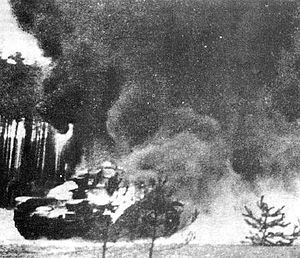Dates 6 Apr 1941 – 9 Apr 1941 | Result German victory | |
 | ||
One Panzer Division
Two Mountain Divisions
Three Infantry Divisions
One Independent Infantry Regiment
One Air Corps with 650 aircraft Greece
Four Divisions and Two Brigades
65,110 officers and other ranks
188 field artillery pieces
76 anti-tank guns
30 anti-aircraft guns
40 tankettes Similar Battle of Greece, Battle of Vevi, Battle of Thermopylae, Capture of Klisura Pass, Battle of Kleisoura Pass | ||
The Battle of the Metaxas Line (German: Kampf um die Metaxas-Linie), also known in Greece as the Battle of the Forts (Greek: Μάχη των Οχυρών), was the first battle during the German invasion of Greece in World War II. The Germans succeeded in breaching the fortified Metaxas Line on the western flank and forced the Greek forces east of the Axios river to surrender after four days of combat (6–9 April 1941).
Contents
Origins of the campaign
The origins of the battle lie in the Italian invasion of Greece, which took place on 28 October 1940. The failure of the Italian Army to bring a favourable end to this Greek-Italian war, forced the Germans to intervene, with an operation they dubbed Operation Marita.
For the purpose of the invasion of Greece, Germany tried to bring Greece's northern neighbours, Bulgaria and Yugoslavia, to the Tripartite Pact alliance. Bulgaria agreed to allow passage of German troops for the attack on Greece, although Bulgarian troops would not participate in combat. Yugoslavia also agreed, but a coup overthrew the Yugoslav government. Although the pact was not denounced, Hitler decided to attack Yugoslavia as well as Greece.
The Metaxas Line
The fortification of the area informally known as the Metaxas Line was conceived as a defensive measure against Bulgaria. Bulgaria had refused to sign the Balkan Pact signed by Greece, Yugoslavia, Turkey and Romania in 1934 which aimed at maintaining the geopolitical status quo in the region following World War I. The Metaxas Line was a series of independent forts along the Greek-Bulgarian border, built on possible routes of invasion. Each fort's garrisons belonged to the division or brigade which controlled the respective border sector. The fortifications were built with the meagre resources that Greece could muster, and exploited at fullest the terrain. Construction had begun in 1936; however, by 1941 the line was still incomplete.
German
The German unit detailed for the invasion of Greece was the 12th Army under Field-Marshal Wilhelm List, with a total of 15 divisions and other elements. Of those the XVIII and XXX Corps were to be used against Metaxas Line:
XVIII Mountain Corps (Lt. Gen. Franz Böhme)
XXX Corps (Lt. Gen. Otto Hartmann)
Greek and Yugoslav
The Greek units responsible for the Metaxas Line were the Eastern Macedonia Army Section under Lieutenant General Konstantinos Bakopoulos and the independent Evros Brigade under Major General Ioannis Zisis:
Eastern Macedonia Army Section (Lt. Gen. Konstantinos Bakopoulos)
West Thrace Zone of operations (Mj. Gen Ioannis Zisis)
The Yugoslav force that contributed directly to the defence of Metaxas Line was the 20th "Bregalnička" Infantry Division, part of the 3rd Territorial Army of the Yugoslav army. It confronted the German 2nd Panzerdivision, which would attempt to outflank the entire Greek position crossing into Greece from Yugoslav territory.
